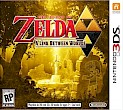Review: The Legend of Zelda: A Link Between Worlds
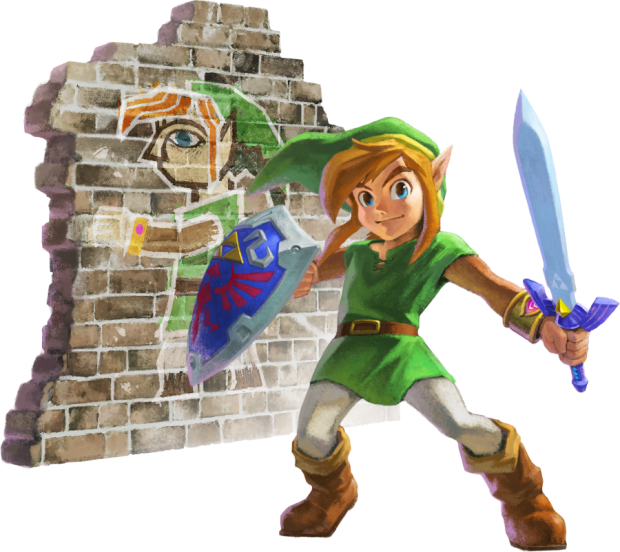
Posted 14 Nov 2013 at 18:00 by Paul Muchmore
At a first glance The Legend of Zelda – A Link Between Worlds returns us to traditional 2D Zelda. After two iterations on the DS, where gameplay was transferred to the touch screen, control of Link has reverted to the 8-directional 2D plane, from a strictly top down view. Set in the world of 1992’s A Link to the Past, it appears as if Nintendo may have lost their imagination. But as with any new Zelda, there’s a twist.
Starting with what seems like a standard Zelda trope, the game begins with Link, our hero, waking up after a bad dream. Working as a blacksmith’s apprentice, he is asked to deliver a sword that a Hylian captain has left behind, which leads him to trouble. A mysterious figure called Yuga has appeared, set on capturing the descendants of the seven sages of Hyrule, by transforming them into paintings. After reporting to the Princess and consulting with the old wise man Sahasrahla, making a return from ALTTP, the fate of Hyrule is once again in the hands of a young boy called Link who wears a green tunic.
While this all sounds very standard so far, after the first dungeon the major change in gameplay is introduced – the ability to turn into a painting. Link is able to merge into any wall for a limited amount of time, allowing him to access places he would never be able to reach by foot. This mechanic is really refreshing and has allowed Nintendo to really mix up the dungeon design and will make you want to explore every part of the over world - even more so than usual. While the map is largely a copy of A Link to the Past’s, the way you approach it will be totally different.
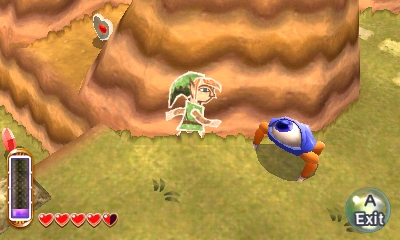 The other big change is the way you collect items. While certain key items are found on your travels, early in the game a strange hooded character named Ravio moves into your home, and sets up shop. Here, you will find the biggest change to Zelda's core mechanics yet – all the weapons you usually find in dungeons are here to rent in the shop. Combine this with the removal of restrictions on the number of rupees you can collect, and you can hold all the items needed to complete the game in your bag right at the start of the game. So what’s the catch?
The other big change is the way you collect items. While certain key items are found on your travels, early in the game a strange hooded character named Ravio moves into your home, and sets up shop. Here, you will find the biggest change to Zelda's core mechanics yet – all the weapons you usually find in dungeons are here to rent in the shop. Combine this with the removal of restrictions on the number of rupees you can collect, and you can hold all the items needed to complete the game in your bag right at the start of the game. So what’s the catch?
If you die, the items will be returned to Ravio. The rupees you've paid = gone. So it becomes a game of risk management – which items do you want to help you through the dungeons, and how much do risk losing if you die? Luckily, at a certain point you are given the option to purchase as well as rent – for example an item that costs 50 rupees to rent may cost 400 rupees to buy. Purchased items are not lost if you die, and you can upgrade them by collecting little seashell creatures called Maiamai and returning them to their octorok mother.
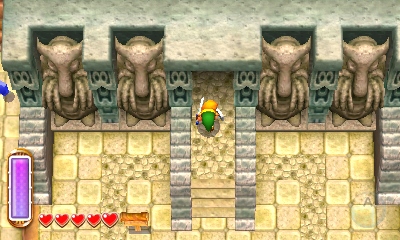 While this appears to give you a lot of freedom to how you play, in reality, all it presents you is the ability to explore the world more freely than you would if items were unlocked by completing dungeons. In this sense, the game is not afraid of letting you get ahead of yourself, and Zelda veterans may relish the challenge of getting through the game on rented items. Unfortunately, rupees are so widely available it never feels like too much of a blow when you die with rented items. Nevertheless, it does sting more than a death in any other Zelda game.
While this appears to give you a lot of freedom to how you play, in reality, all it presents you is the ability to explore the world more freely than you would if items were unlocked by completing dungeons. In this sense, the game is not afraid of letting you get ahead of yourself, and Zelda veterans may relish the challenge of getting through the game on rented items. Unfortunately, rupees are so widely available it never feels like too much of a blow when you die with rented items. Nevertheless, it does sting more than a death in any other Zelda game.
In addition, gone are the days of collectible bombs and arrows. All weapons, as well as the ability to turn into a painting, are limited to a purple meter shown on the screen alongside your health. Fire your arrows too liberally and you’ll be waiting a while for your meter to automatically refill before being able to fire again. This really adds a new dimension of battle tactics to Zelda’s combat.
The aspect of freedom carries over to how you approach dungeons. While A Link Between Worlds follows the usual three dungeons - discover real scope of game – seven dungeons formula, you can take on the dungeons in their respective groupings in whatever order you please.
After a certain point, Link must travel through cracks in walls to visit Hyrule’s dark equivalent – cleverly named Lorule. Similar to A Link to the Past’s dark world, this monster-ridden land is where you will find the bulk of the adventure. Unlike Hyrule, Lorule is a very divided land, with each region only accessible from cracks in their light equivalent. Crossing between worlds through different cracks is the only way to discover all the secrets both worlds have to behold.
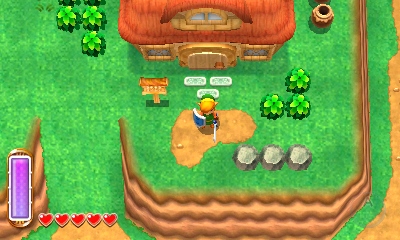 Unfortunately, the interiors of the dungeons themselves don’t have such an open approach, with most dungeons still employing the use of one key item to complete the level. Early dungeons will even tell you on pillars outside which item you will need. Thanks to the many quick travel points, usable from early in the game, it means a trip back to Ravio won’t cause you too much hassle if you haven’t brought along what you need.
Unfortunately, the interiors of the dungeons themselves don’t have such an open approach, with most dungeons still employing the use of one key item to complete the level. Early dungeons will even tell you on pillars outside which item you will need. Thanks to the many quick travel points, usable from early in the game, it means a trip back to Ravio won’t cause you too much hassle if you haven’t brought along what you need.
Despite this, the dungeons do feel inventive and new, especially freshened with the wall-merging mechanic, which can also be really handy for a tactical evasion of conflict. There are some puzzles that will really have you scratching your head, and some optional chests that had me stuck for ages trying to reach them. I was impressed by the boss battles, but unfortunately the mid-temple mini-boss fights felt flat and unimaginative with no new item at stake.
The biggest flaw of the open world mechanic is that between the major cut scenes at the start, midpoint and end, there is little development of the story as you progress. Because you can visit the Lorule dungeons in any order, there is no feeling from the narration that you have really advanced much further on your journey whether you’ve just defeated your first one or your sixth. I would have also liked to have more of a connection with the sages personally before they are rescued – in some cases it just feels like they’re a name.
As recent Zeldas on both the Wii and DS have been largely driven by their story, it feels like a step backwards. Maybe your nostalgia for A Link to the Past will shine over this, but for me it would have been nice if they mixed the best of classic 2D Zelda with the modern storytelling values we’ve come to expect.
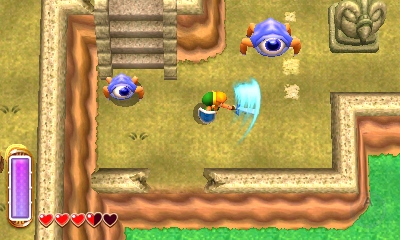 The world is full of weird, wonderful, and brilliantly designed characters to meet and things to do for them. With the scripting work as good as ever, it makes the world feel alive. Puzzle dungeons that put your ability to turn into a painting to the test are dotted in hidden caves around Hyrule, and several mini-games provide a tricky challenge to win rupees and heart pieces. Perhaps the strangest one is an Octorok baseball game, in which you must swing at the correct time to smash pots full of rupees dotted around the field. Along with collecting Maiamai and finding heart pieces, there’s plenty to do on top of the main quest, which was completed by this reviewer in around 16 hours – pretty standard for a handheld Zelda.
The world is full of weird, wonderful, and brilliantly designed characters to meet and things to do for them. With the scripting work as good as ever, it makes the world feel alive. Puzzle dungeons that put your ability to turn into a painting to the test are dotted in hidden caves around Hyrule, and several mini-games provide a tricky challenge to win rupees and heart pieces. Perhaps the strangest one is an Octorok baseball game, in which you must swing at the correct time to smash pots full of rupees dotted around the field. Along with collecting Maiamai and finding heart pieces, there’s plenty to do on top of the main quest, which was completed by this reviewer in around 16 hours – pretty standard for a handheld Zelda.
While Phantom Hourglass and Spirit Tracks shifted gameplay totally to the touch screen, A Link Between Worlds uses the bottom screen purely for organisation. From here you can access your inventory and gear screens, which do pause the game – no on the fly switching (apart from between your two button-assigned weapons) here. In contrast, the map can be browsed while travelling the world, with the ability to place pins on any points of interest. Unfortunately the ability to write notes like in the DS games have gone, but the pin system is a decent compromise that will challenge you to remember exactly why you placed a pin.
You can play A Link Between Worlds with the 3D effect turned off. But why would you want to when it looks so great? While the art style is slightly peculiar and won’t be to everybody’s tastes, the 3D effect really accentuates the depth and height of platforms, with more dungeons than usual making use of multiple levels. But what really stands out is the pop out effects. In one dungeon, Link will be sprung from one level to another, and he literally jumps out of the screen. When arrows hit a wall, it will bend and recoil slightly towards your eyes. While this doesn’t affect gameplay at all, these little touches show the attention to detail put into crafting this beautiful world.
Production values are similarly high in the audio department. Sound effects are ripped straight from A Link to the Past, giving you a real sense of nostalgia. Without a doubt, the “mystery solved” jingle will bring a smile to your face when you hear it.
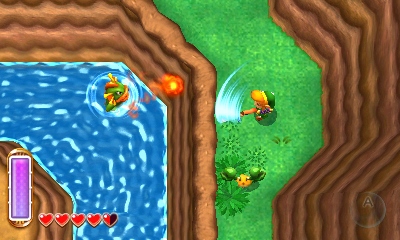 Overall, I had lot of fun with A Link Between Worlds. The quality of gameplay is just what you’d expect from 2D Zelda, and when you reach the final heart-warming scenes, it is hard to feel disappointed. It should also be applauded for mixing things up – the item rental system is a great idea and ties directly into the plot of the game, which I won’t spoil in this review. There is little hand holding here – players are free to explore as they please, and if you are stuck, you can pay a visit to the fortune teller, or equip “hint glasses” which allow you to interact with a ghost who will give you a hint in exchange for a 3DS play coin.
Overall, I had lot of fun with A Link Between Worlds. The quality of gameplay is just what you’d expect from 2D Zelda, and when you reach the final heart-warming scenes, it is hard to feel disappointed. It should also be applauded for mixing things up – the item rental system is a great idea and ties directly into the plot of the game, which I won’t spoil in this review. There is little hand holding here – players are free to explore as they please, and if you are stuck, you can pay a visit to the fortune teller, or equip “hint glasses” which allow you to interact with a ghost who will give you a hint in exchange for a 3DS play coin.
Unfortunately, the desire for an open-world game has had a detrimental effect on the game’s storytelling, which makes it lag during the middle act of the game. While punished more than other Zeldas, death still feels like little more than an inconvenience, with rupees too readily available. The sparseness of the plot made it feel like the game flew by quicker than it actually did. For those who played A Link to the Past when it was first released the nostalgic nods will make these flaws more bearable; but those who are more familiar with modern Zelda may find themselves a little lost without the story guiding them around Hyrule and its dark counterpart.
N-Europe Final Verdict
A Link Between Worlds is a beautifully crafted sequel to A Link to the Past. Transforming into a painting is a inventive and fun mechanic which has led to some of the best dungeons that Link has battled through yet. But freedom afforded to players adds and detracts from the game in equal measure, stopping this Zelda from becoming one of the true greats.
- Gameplay5
- Playability4
- Visuals4
- Audio5
- Lifespan4
Final Score
9
Pros
Captures the spirit of traditional 2D Zelda, while mixing it up with new ideas
Merging into the walls is a lot of fun
Brilliant dungeons and bosses
Cons
Storytelling is diminished in favour of player freedom
Too many rupees prevents death from being much more than an inconvenience
Sometimes feels too similar to A Link to the Past


